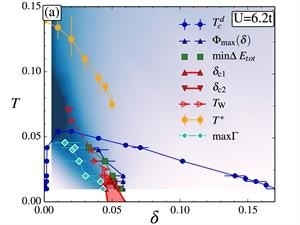Mar 16 2016
The challenge of high temperature superconductivity in the cuprates triggers innovative scientific investigations. A key question remains the complexity of the phase diagram. As temperature and doping change, these materials switch between superconducting, metallic, and insulating phases, as well as other more exotic phases, such as the elusive pseudogap.
 Temperature-doping phase diagram revealed by the new research. Red curve indicates the normal-state crossover emanating from the endpoint of a first-order transition. That is the organising principle for the superconducting phase (delimited by blue line)
Temperature-doping phase diagram revealed by the new research. Red curve indicates the normal-state crossover emanating from the endpoint of a first-order transition. That is the organising principle for the superconducting phase (delimited by blue line)
The new research, by a team at Royal Holloway University of London and Universite' de Sherbrooke in Canada, found an organising principle for the superconducting phase diagram that is quite general.
Theoretical insights were obtained by solving the archetypal model of strongly correlated electron systems with state of the art numerical algorithms using the second largest supercomputer in Canada. This team had found earlier that the phase boundary between pseudogap and correlated metal consists of a sharp border, i.e. a first-order transition line at finite doping that starts at zero temperature and ends at a finite temperature critical point. Beyond that point, the phase boundary continues as a crossover line, called a Widom line. The new findings are that this transition and associated Widom line do much more than control the normal state phase diagram, they allow one to make sense of universal features of the temperature-doping phase diagram, namely:
- Why is there a dome of superconductivity and why is it shaped this way?
- Why is there a change in the pairing mechanism as a function of doping?
- What is the nature of the intricate interplay between the pseudogap and superconductivity?
The work demonstrates that, although the first-order transition disappears in the superconducting state, it impacts the superconducting properties in a major way, providing an organising principle for the whole phase diagram. This is the decisive step. From a broader perspective, the results demonstrate how and to what extent a crossover radiating out of a first-order transition can be a source of complex behaviour in broken symmetry phases that mask the normal-state transition. This may be a much more general organising principle for phases of matter.
This novel hypothesis is testable. Whether or not such a phase transition exists in cuprates has now to be experimentally tested.
This research is described today (11 March 2016) in the journal Scientific Reports: http://www.nature.com/articles/srep22715